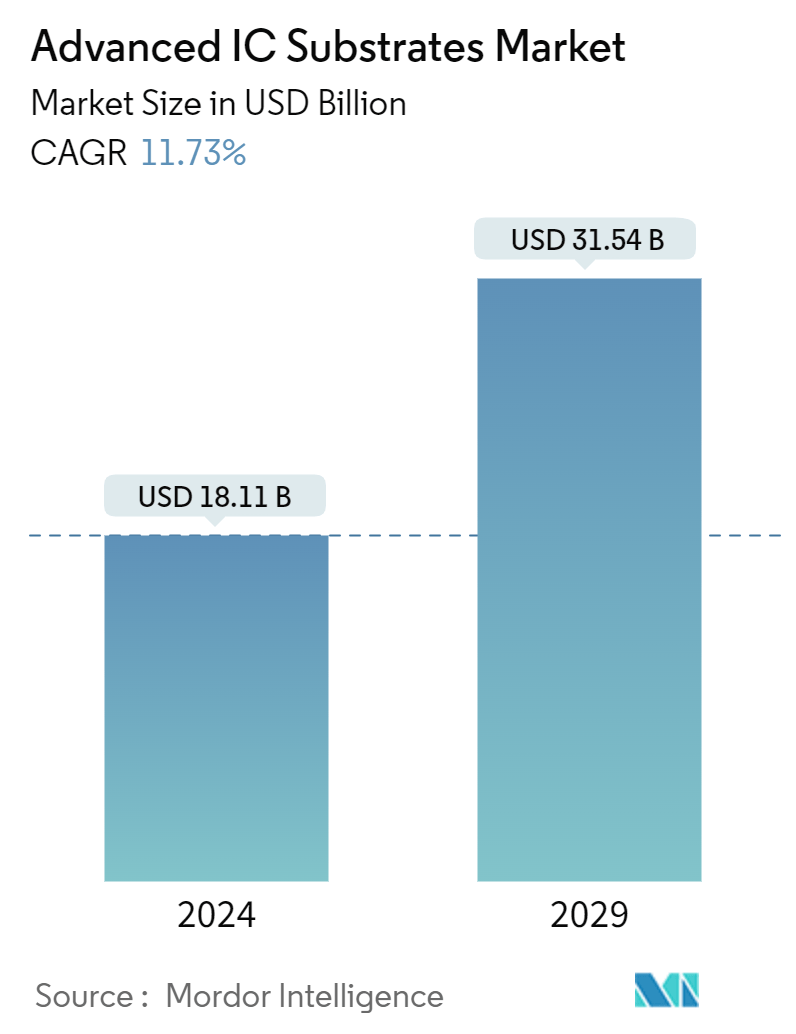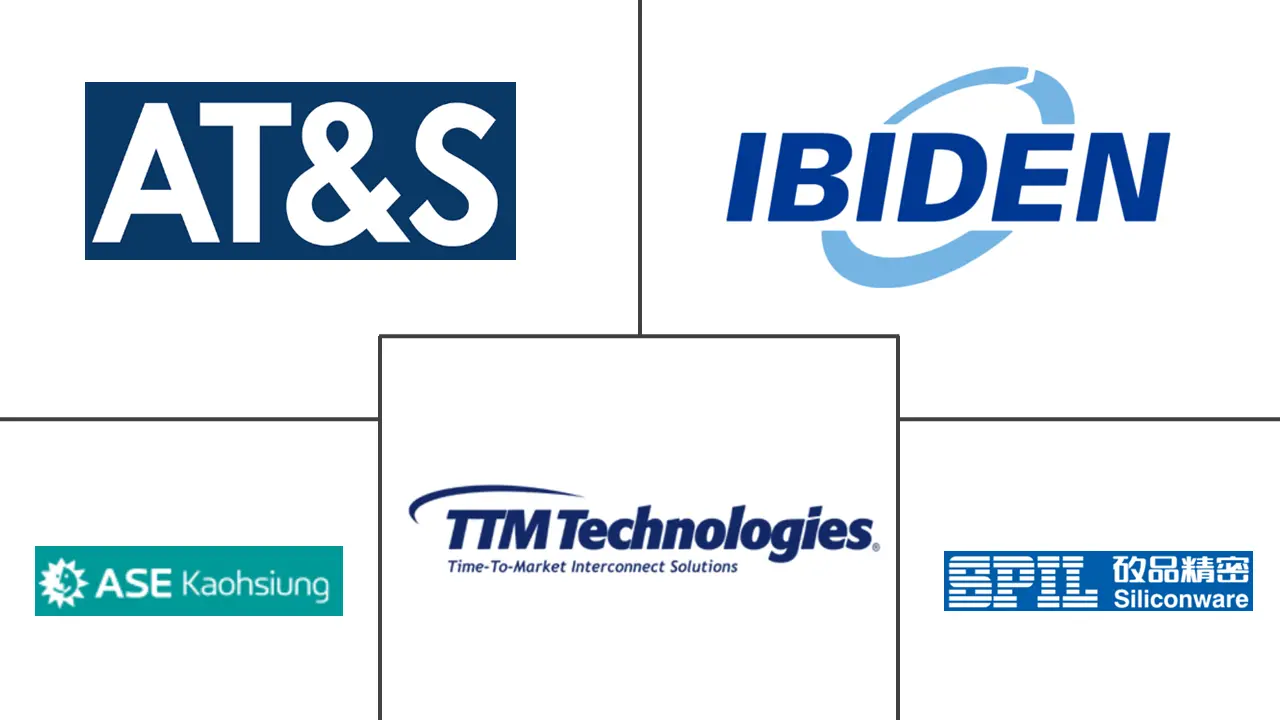Market Size of Advanced IC Substrates Industry

| Study Period | 2019 - 2029 |
| Market Size (2024) | USD 18.11 Billion |
| Market Size (2029) | USD 31.54 Billion |
| CAGR (2024 - 2029) | 11.73 % |
| Fastest Growing Market | Asia Pacific |
| Largest Market | Asia Pacific |
Major Players
*Disclaimer: Major Players sorted in no particular order |
Advanced IC Substrate Market Analysis
The Advanced IC Substrates Market size is estimated at USD 18.11 billion in 2024, and is expected to reach USD 31.54 billion by 2029, growing at a CAGR of 11.73% during the forecast period (2024-2029).
Players are continuously advancing their packaging technologies to cater to stringent requirements with a smaller footprint, higher performances, and lower power consumption. The demand for consumer electronics and mobile communication devices drives electronics manufacturers to deliver more compact and portable products.
- The increasing trend of miniaturization is driving the demand for advanced packaging. The advent of 5G, which influenced the demand over the past few years, is expected to continue as the use of FCBGA in 5G base stations and HPCs is increasing in countries adopting communication technology.
- FCBGA is expected to hold a significant share of the market demand, owing to its routing density availability, as it can be tuned for maximum electrical performance. The key players in the market are Unimicron, ASE Group, IBIDEN, and SCC. For instance, Unimicron and Kinsus are expanding their substrate capacities. Unimicron has announced that it would be investing a total of TWD 20 billion in R&D and expansion of its production capacity for advanced flip-chip substrates through 2022.
- Apart from this, the global demand for IoT, in both the consumer and industrial spaces, is expected to add to the increasing demand for the IC substrate. According to the Ericsson the In 2022, the number of short-range internet of things (IoT) devices reached 10.3 billion worldwide. That number is forecast to increase to 25 billion by 2027. The wide-area IoT devices amounted to 2.9 billion in 2021 and are predicted to reach 5.4 billion by 2027., and industrial IoT demand is expected to exceed consumer demand over the coming years. Such developments are expected to influence the market positively.
- The advanced substrate industry follows miniaturization trends, greater integration, and higher performance. Owing to this, several players across the ongoing ED and SLP packaging are making huge investments and showing an increased interest in such technologies.
- The higher power density and board integration result in thermal benefits, thereby enabling further improvements in system reliability. Such technologies bring massive value to the market due to extended adoption across automotive applications.
- They also drive the telecom and infrastructure segment, where ED is a suitable substrate solution for increased hardware efficiency. Due to this, players are investing huge amounts in new plants where ED is expected to be the main product constituent.
- Despite the potential of IC substrates, changing preferences are likely to slow down market growth. For instance, some companies utilize a silicon interposer with multiple RDLs for a better connection between logic and HBM. Others use fan-out-on-substrate with RDLs. FCBGA needs a substrate supplier, wafer bumps, and wafer fab capacity for RDLs and assembly and testing. But FO WLP only requires assembly and wafer fabs for RDLs and wafer bumps and testing. Hence, the industry is witnessing a shift toward FOWLP.
- Amid COVID-19, and post of it the rising adoption of electric vehicles, robotic applications, sensing products such as image sensors, 5G smartphone penetration, increased demand for smart consumer electronics, medical wearables, and industry 4.0 has fueled technological advancements by increasing demand for advanced and tiny chip requirements, For instance, According to Ericsson 5G subscriptions are forecast to increase drastically worldwide from 2019 to 2028, from over 12 million to over 4.5 billion subscriptions
Advanced IC Substrate Industry Segmentation
IC substrates serve as the connection between the IC chip(s) and the PCB through a conductive network of traces and holes. IC substrates support critical functions, including circuit support and protection, heat dissipation, and signal and power distribution.
The advanced IC substrate market is segmented by type (FC BGA and FC CSP), application (mobile and consumer, automotive and transportation, IT and telecom), and geography (United States, China, Japan, South Korea, Taiwan, and the rest of the world). The report offers market forecasts and size in value (USD) for all the above segments.
| By Type | |
| FC BGA | |
| FC CSP |
| By Application | |
| Mobile and Consumer | |
| Automotive and Transportation | |
| IT and Telecom | |
| Other Applications |
| By Geography | |
| United States | |
| China | |
| Japan | |
| South Korea | |
| Taiwan | |
| Latin America | |
| Middle East and Africa |
Advanced IC Substrates Market Size Summary
The advanced IC substrate market is poised for significant growth, driven by the increasing demand for miniaturized and high-performance electronic devices. As consumer electronics and mobile communication devices become more compact and portable, the need for advanced packaging solutions is escalating. The advent of 5G technology has further fueled this demand, particularly with the use of Flip-Chip Ball Grid Array (FCBGA) in 5G base stations and high-performance computing systems. Key industry players, including Unimicron, ASE Group, and IBIDEN, are investing heavily in research and development to enhance their substrate capacities and meet the evolving market requirements. The market is also witnessing a shift towards Fan-Out Wafer Level Packaging (FOWLP) due to its streamlined manufacturing process and reduced dependency on substrate suppliers.
The global push towards smart devices, IoT, and Industry 4.0 is expected to bolster the demand for advanced IC substrates across various sectors, including automotive, telecommunications, and consumer electronics. China's aggressive strategy to bolster its semiconductor industry, supported by substantial government investments, is anticipated to significantly impact the market landscape. The country's focus on achieving self-sufficiency in semiconductor production by 2025 is driving the demand for advanced substrates. Additionally, the introduction of innovative technologies, such as glass cores by SCHMID Group and Intel, is set to enhance the performance and flexibility of IC substrates, catering to the burgeoning needs of data centers, AI, and high-speed computing applications.
Advanced IC Substrates Market Size - Table of Contents
-
1. MARKET INSIGHTS
-
1.1 Market Overview
-
1.2 Industry Attractiveness - Porter's Five Forces Analysis
-
1.2.1 Bargaining Power of Suppliers
-
1.2.2 Bargaining Power of Consumers
-
1.2.3 Threat of New Entrants
-
1.2.4 Threat of Substitutes
-
1.2.5 Intensity of Competitive Rivalry
-
-
1.3 Industry Value Chain Analysis
-
1.4 Assessment of the COVID-19 Impact on the Industry
-
-
2. MARKET SEGMENTATION
-
2.1 By Type
-
2.1.1 FC BGA
-
2.1.2 FC CSP
-
-
2.2 By Application
-
2.2.1 Mobile and Consumer
-
2.2.2 Automotive and Transportation
-
2.2.3 IT and Telecom
-
2.2.4 Other Applications
-
-
2.3 By Geography
-
2.3.1 United States
-
2.3.2 China
-
2.3.3 Japan
-
2.3.4 South Korea
-
2.3.5 Taiwan
-
2.3.6 Latin America
-
2.3.7 Middle East and Africa
-
-
Advanced IC Substrates Market Size FAQs
How big is the Advanced IC Substrates Market?
The Advanced IC Substrates Market size is expected to reach USD 18.11 billion in 2024 and grow at a CAGR of 11.73% to reach USD 31.54 billion by 2029.
What is the current Advanced IC Substrates Market size?
In 2024, the Advanced IC Substrates Market size is expected to reach USD 18.11 billion.

